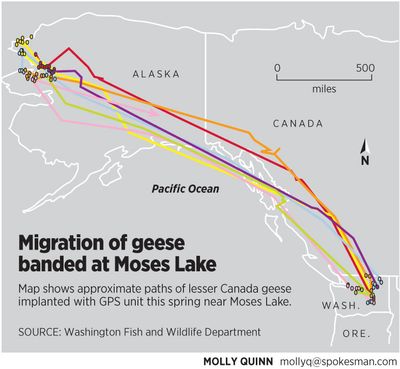GPS tracks migrating geese

Washington wildlife biologists are using Global Positioning System technology to unravel the marvel of migration.
Seven adult female lesser and Taverner’s Canada geese were captured in March and April near Moses Lake so GPS transmitters could be surgically implanted, said Mikal Moore, state Fish and Wildlife Department waterfowl specialist.
“These subspecies do not nest in Eastern Washington,” she said, a statement confirmed by satellite tracking.
When spring triggered the migration instinct, the birds wasted little time. They flew roughly 2,200 miles in about two weeks to their breeding grounds near Kotzebue, Alaska, and the Lisburne Peninsula.
“It is remarkable that they are all still alive considering the energetic toll the flight takes,” Moore said.
Each of the geese likely produced a crop of young geese in the bountiful arctic daylight.
Recent tracking reports indicate the birds were staging their fall migration, with some already headed back south. Their initial routes seemed to be fairly direct but a bit farther east from their northward journey.
Moore said she was watching the routes with great interest this week, since it’s the first southward migration in the study.
Typically the geese return to Eastern Washington in mid-October, she said.